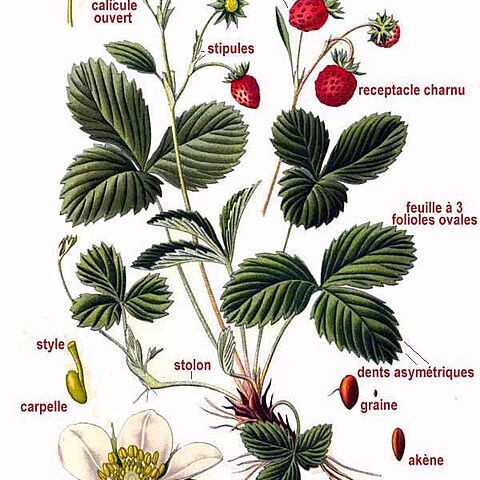Herbs perennial, mostly stoloniferous, polygamo-dioecious, usually spreading or appressed hairy. Stolons often rooting at nodes and forming plantlets. Leaves alternate, petiolate; stipules adnate to base of petiole, often membranous, sheathing; leaf blade 3-foliolate or pinnately 5-foliolate. Inflorescence erect, cymose or corymbiform, few flowered, rarely a solitary flower. Hypanthium obconic or turbinate. Sepals 5, valvate, persistent; epicalyx segments 5, alternating with and smaller than sepals, margin entire. Petals 5, white, rarely yellow, broadly obovate or suborbicular. Stamens numerous; anther 2-loculed. Carpels numerous, free, borne on convex receptacle; ovule ascending from middle of locule; style adaxial, short, persistent. Aggregate fruit formed from enlarged receptacle, berry-like, long conic to globose, fleshy. Achenes numerous, seated in pits on surface of aggregate fruit, minute, brittle. Seed testa membranous; cotyledons convex. x = 7.
Short-stemmed, perennial, mat-forming herbs, not armed, with long, ± leafy runners. Lvs in basal rosettes, sometimes in clusters scattered along runners or cauline, long-petiolate, pinnately 3-foliolate or rarely pinnate or 1-or 5-foliolate, dentate or crenate; stipules free in upper part and adnate to petiole below, persistent. Infl. of 1-several, small-to medium-sized, ☿ fls borne on slender peduncle arising from basal rosettes or in axils of runner lvs. Hypanthium with a central, convex, spongy receptacle (carpophore). Epicalyx segments leafy, entire to toothed. Calyx usually with 5 ± triangular and prominent sepals. Petals 5, ± obovate, usually white, rarely yellow. Stamens 10-30. Ovary superior; carpels 10-80; styles surrounded by hypanthium rim; ovules 1 per carpel. Fr. a head of many achenes in pits on surface of soft, fleshy, coloured receptacle, the styles deciduous at fruiting.
Hypanthium saucer-shaped; sep 5, alternating with foliaceous bracts of nearly equal size; pet 5, white, obovate to subrotund; stamens numerous; with short filaments; pistils numerous, inserted on a prolongation of the receptacle; style slender, lateral; fr of numerous achenes on a greatly enlarged, juicy, edible red receptacle, subtended by the persistent calyx and bracts; perennial herbs, usually spreading freely by runners, with basal, 3-foliolate, serrate lvs and scape-like peduncles bearing few to several fls. 30, N. Temp., S. Amer.
Perennial stoloniferous herbs. Leaves trifoliolate, densely clustered from a basal rosette. Flowers pentamerous, protogynous. Petals and epicalyx present. Fruit consisting of many, small 1-seeded achenes covering the accrescent, juicy, succulent receptacle.
Herbs, mosdy with stolons. Leaves trifoliolate. Inflorescences cymose, few-flowered. Flowers 5-merous. Petals white. Stamens many. Pistils many, style ventral. Fruits on enlarged, fleshy torus, forming a spurious fruit.


